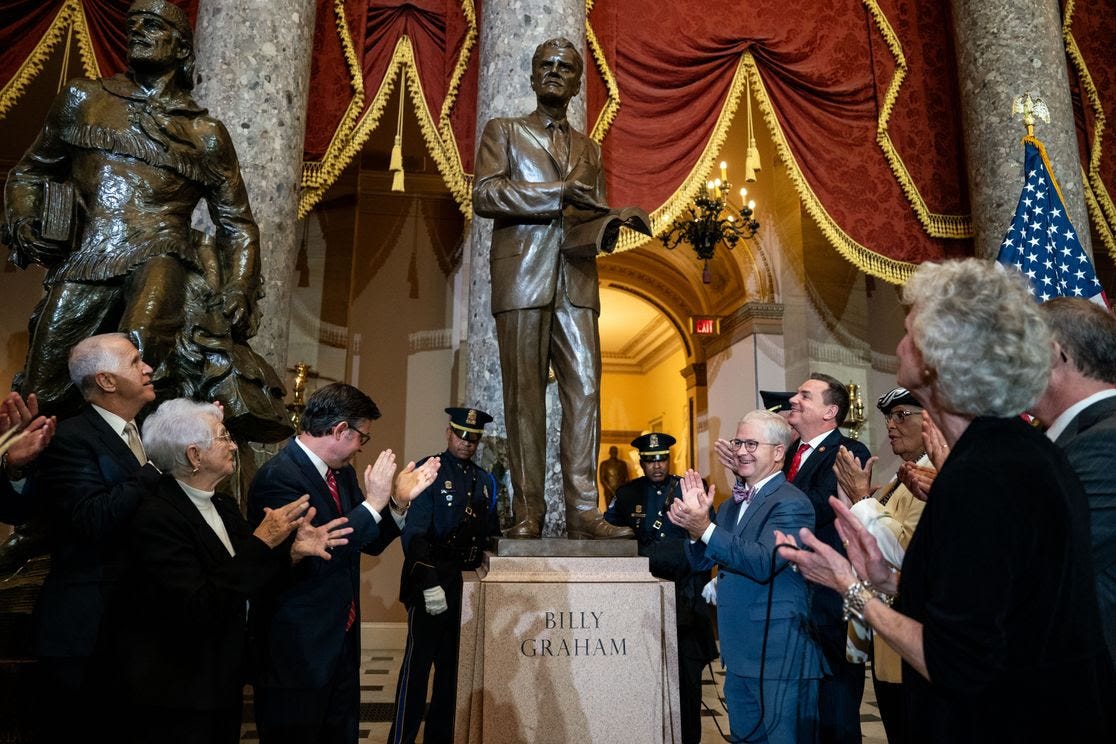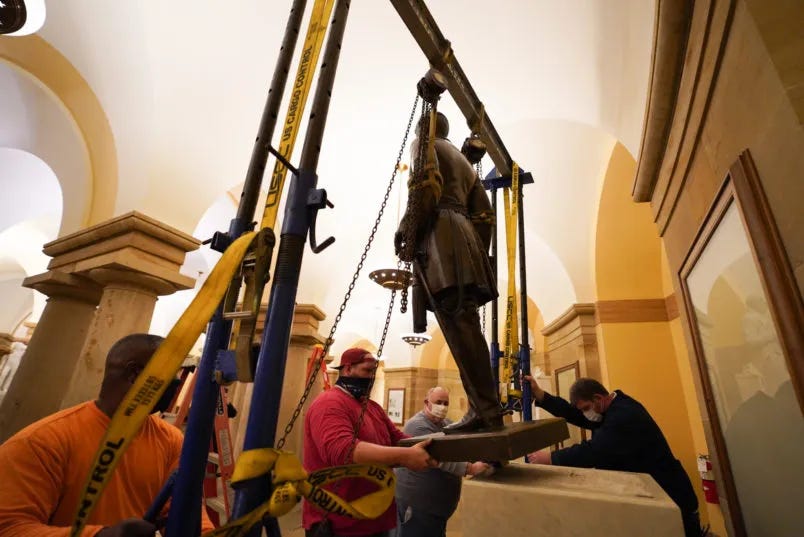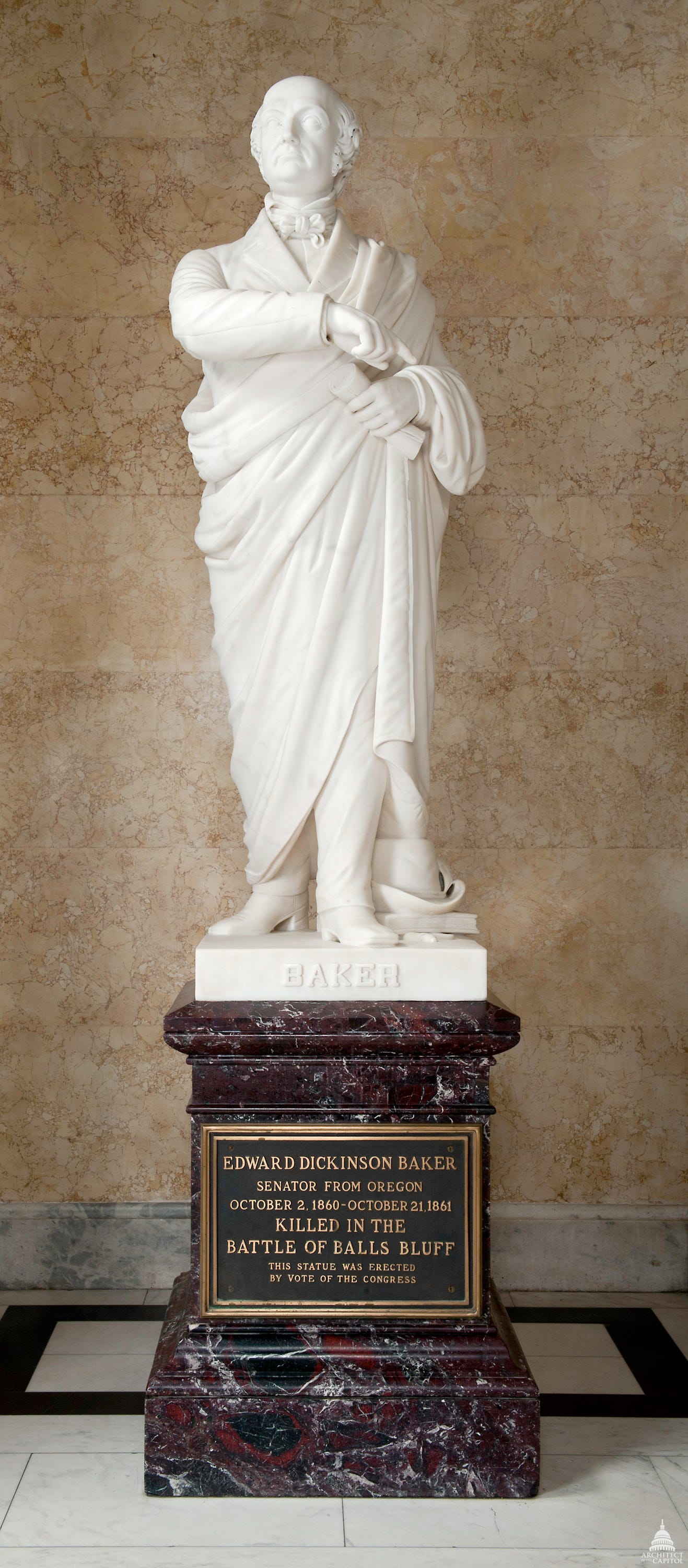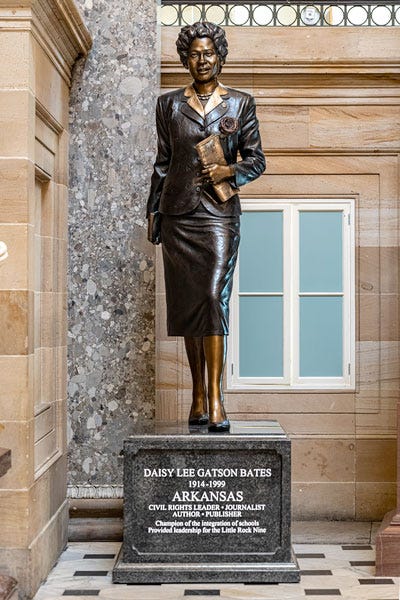The Statues, They Are "a-Changin"
Any first-time visitor to the US Capitol will be struck by the National Statuary Hall Collection. A few "controversial" ones are now being replaced. Is this a good thing?
Congress may be short on civility and decorum, but there’s one thing it’s not short on: statues and sculptures. The politically incorrect or forgotten ones are being swapped out for more culturally palatable 20th-century individuals, including those far less known than the historical figures they’re replacing.
Most of the nation’s 49 Vice Presidents have one. Every state has two. Only in recent years has every state finally met its quota. Others are placed by legislation or gifts accepted by the House and Senate. They include sculptures of Italians, Hungarians, and Polish figures such as Giuseppe Garibaldi, Constantino Brumidi, Lajos Kossuth, and Casimir Pulaski.
And yes, there’s probably room for a few more. Politics and nature abhor a vacuum.

Every Capitol tour I conduct includes pointing out certain busts and statues and their stories and histories. Some of the statues I take special time for include Richard Nixon’s vice presidential bust just outside the Senate chamber’s rear and close to my former Secretary of the Senate’s office in S-208 (now belonging to the Assistant Republican Senate Leader, John Thune [R-SD]). The location of Nixon’s bust on November 7, 1983, used to contain a bench under which a bomb detonated that evening, minutes after the Senate adjourned a late-night session. It was planted there by the infamous May 19 group, an all-female-led terror group protesting US policies in Central America. No one was hurt, but the damage and the consequences - the permanent installation of magnetometers - were considerable.
Other busts I point out include Oklahoma’s contributions, including Cherokee chief Sequoyah, who wrote his tribal nation’s alphabet, and America’s first “stand-up comic,” Vaudeville star and humorist Will Rogers. About a century ago, Rogers was alive (he died in a plane crash in Alaska shortly thereafter) when Oklahoma legislators decided to commemorate its native son with one of its two Capitol statues. He asked that it be placed where he could “keep an eye on Congress.” Sure enough, his statue faces the entrance to the House chamber. Rubbing the toes of his shoe brings good luck, the legend goes. Who am I to argue?
Other notable ones I love to point out: California’s Father Junipero Sierra, the priest who established the chain of Catholic missions along the Golden State’s coast; Andrew Jackson, whose statue at the Capitol Rotunda’s exit towards the Senate stands near where he not only survived an assassination attempt - the assassin’s guns misfired twice - but bludgeoned the attacker with his cane. The attacker, a painter, was eventually subdued by US Rep. Davey Crockett (D-TN), of coonskin cap and Alamo fame.
Newer statues include Rosa Parks, whose refusal to yield her “colored” seat on a bus to a white person in 1955 led to a Supreme Court decision outlawing segregation. Parks’ is the only one in Statuary Hall that was not placed by a state but through legislation. As a food industry veteran, I love pointing out Dr. Norman Borlaug, who stands next to Parks and won the Nobel Peace Prize for saving millions of lives through plant breeding innovations. He’s one of Iowa’s two contributions.
I also spend time pointing out the statues of Jefferson Davis and Alexander Stephens. You know, the President and Vice President of the Confederate States of America, but also, at various times, distinguished Members of Congress. More about them later.
The last statue I point out is former Representative and US Senator Edwin Dickenson Baker (Whig/R-IL/OR). Baker not only defeated Abraham Lincoln for a US House seat from Springfield, Illinois, in 1846, but as a new US Senator from Oregon, raised his own Union regiment and lost his life in 1861 at the Battle of Ball’s Bluff along the Potomac River near Leesburg, VA. He’s the only sitting US Senator to have died in combat.
The US Capitol’s love affair with statues probably began with the National Statuary Hall Collection just before the outbreak of the Civil War, during a major expansion that included new House and Senate chambers and a nine-million-pound new cast-iron dome that remains to this day a global symbol of democratic (if messy) government.
Legislation was enacted in 1864 to allow each state to gift two statues of deceased citizens known for their “historic renown:”
[...] the President is hereby authorized to invite each and all the States to provide and furnish statues, in marble or bronze, not exceeding two in number for each State, of deceased persons who have been citizens thereof, and illustrious for their historic renown or for distinguished civic or military services such as each State may deem to be worthy of this national commemoration; and when so furnished the same shall be placed in the Old Hall of the House of Representatives, in the Capitol of the United States, which is set apart, or so much thereof as may be necessary, as a national statuary hall for the purpose herein indicated.
During the late 1990s, a growing movement of political “correctness” led many to demand certain statues be removed. However, the 1864 law didn’t include a provision for swapping out statues. In 2000, Congress enacted legislation to allow states to substitute them. When Statuary Hall became overwhelmed with statues, they were moved to other parts of the Capitol, eventually including the Capitol Visitor’s Center, completed in 2008.

Kansas was the first to substitute one of its statues with Dwight D. Eisenhower, who is now prominently placed in the Rotunda beside Ronald Reagan. Statues of Harry Truman (Missouri) and Gerald Ford (Michigan) have now joined them.
This month, the late evangelist Billy Graham replaced a statue honoring North Carolina Gov. Charles Aycock. The next new statue will feature Barbara Johns, a Civil Rights Activist from Virginia who will replace the departed and better-known Robert E. Lee in the Capitol's crypt, immediately below the rotunda. The 40-column crypt features a statue from each of the original 13 states.
Arkansas is another state that has begun to replace its statues, thanks to a law signed in 2019 by then-Gov. Asa Hutchinson. Daisy Bates, a civil rights activist, is also newly featured in the Capitol’s Statuary Hall. She will soon be joined by Johnny Cash, location TBD. One of the statues they’re replacing is Uriah Milton Rose, a fiercely loyal Confederate who later founded the infamous Rose Law Firm of Hillary Clinton, Vince Foster, and Webster Hubbell fame. What’s left of the law firm is probably grateful.
However, two statues remain for now: Davis, a gift from Mississippi installed in 1931, and Stephens, one of Georgia’s two contributions, installed in 1927. During the Summer of “fiery but mostly peaceful protests” following George Floyd's death in 2020, Congressional Democrats demanded the removal of all Capitol statues featuring former Confederates. They failed, but some states have followed suit, including Florida, which replaced Confederate General Edmund Kirby Smith with Civil Rights activist Mary McLeod Bethune.
It may be only a matter of time before Mississippi relents (they rebuffed such a move in 2021). It is the same with Georgia and Stephens, who briefly served as Governor after the Civil War following a decade in Congress. Same with South Carolina’s contributions, including the legendary southern member of the Senate’s famous “triumvirate” of the 19th Century, former Vice President and US Sen. John C. Calhoun. Suggestions that the state remove the statues, especially after the tragic killing of nine black South Carolinians at Charleston’s Emanuel AME Church by a white racist in 2015, have been rebuffed and largely ignored in the Palmetto State. For now.
Go easy and thoughtfully on the substitutions.
I get why states and Congress feel pressure to replace their statutes. Their selection reflects on them, and history marches on, including new and important figures that show the state more favorably in today’s popular culture.
I don’t quarrel with most substitutions, especially the new ones from North Carolina and Arkansas. However, many of these statues represent people with complicated yet important histories - especially Davis, who served as President Franklin Pierce’s Secretary of War and made his mark on the nation before the Civil War. The same happened with Calhoun, the only vice president to two sitting presidents.
No doubt Stephens was an avowed racist. Just read his “Cornerstone” speech from March 1861, just before the initiation of hostilities at Fort Sumter, South Carolina.
Our new (Confederate) government is founded upon exactly the opposite idea; its foundations are laid, its corner-stone rests, upon the great truth that the negro is not equal to the white man; that slavery subordination to the superior race is his natural and normal condition. This, our new government, is the first, in the history of the world, based upon this great physical, philosophical, and moral truth.
Abraham Lincoln was less interested in abolishing slavery—he was, of course, although he thought it destined to die gradually, a view largely shared by Robert E. Lee—than in preserving the Union. I fear, however, that the rush to remove statues en banc in response to a tragedy disserves the very cause proponents profess to proclaim. Such decisions made in the heat or aftermath of a tragic moment strike me as a political opportunity that isn’t to be wasted, to borrow a phrase from former US Representative, Chicago Mayor, and Ambassador to China, Rahm Emmanuel.

These statues of iconic figures, warts, and all remind us of history—an important history that should be learned from so as not to be repeated. Each statue is a life and a story, a complicated mosaic worth dissecting, remembering, and sharing. Robert E. Lee’s contributions to reunifying the nation after the Civil War are underappreciated.
Louisiana's contributions include Edward Douglass White and the legendary Huey P. Long. White was a Confederate soldier who later distinguished himself as a United States Senator and justice and was elevated—the first—to the position of Chief Justice of the US Supreme Court. While his record wasn’t perfect, he wrote the opinion for a unanimous majority that struck as a “repugnant” violation of the 15th Amendment southern “grandfather clauses” to literacy tests some states required to vote and discriminated against black Americans. Many Confederates opposed secession and found slavery “evil” but enlisted in loyalty to their states.
History is complicated.
Sadly, too many in Congress and states have been infected with presentism: judging people and events through a “modern” lens, intending to erase history rather than learn from it. And we know what happens when you don’t learn from history.
Even conservative Utah seems to have fallen victim. They are replacing a statue of Philo T. Farnsworth, the inventor of the electronic television, with polygamous suffragist Martha Hughes Cannon, the first female ever elected to a state senate. Farnsworth, whom Time Magazine named one of the 100 most influential people of the 20th Century, has had a much more profound impact on society—maybe if he were only a female.
After all, now that we’ve begun replacing statues, where will they stop?
Come senators, congressmen
Please heed the call
Don’t stand in the doorway
Don’t block up the hall
For he that gets hurt
Will be he who has stalled
There’s a battle outside and it is ragin’
It’ll soon shake your windows and rattle your walls
For the times they are a-changin’From “The Times, They Are a-chagin,” by Bob Dylan, 1963








Presentism is a scourge, where history is replaced by fleeting fads that will die an inconspicuous death.
Great article. Like naming streets, I think a community or state has the right to change who it honors if a majority of that community supports it. But outsiders should not be able to compel that. Having said that, I would not mind seeing Jefferson Davis in the dustbin of history. Robert E Lee reluctantly decided he needed to defend his home state. Davis enthusiastically led a rebellion against the United States that resulted in 600,000 people dying. Mississippi can do better than that.